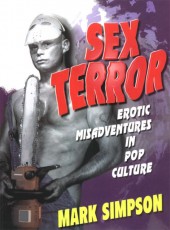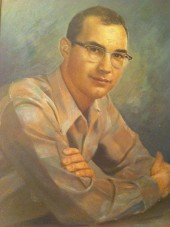 Sex Terror:
Sex Terror:
Erotic Misadventures in Pop Culture
by Mark Simpson
Published by Harrington Park Press
Published May 16, 2002
Nonfiction
264 pgs. • find on Amazon

September 2, 2003.
To anyone interested in books and history and frustrated that a good book or a fact of history has been ignored by the media that claims to be interested in covering such books and history, the question of how to get such a book or fact discussed is a constant quest.
I am thinking of a particular book and a “fact” I find in the book. But the connection to Gay and Lesbian Review is that a reviewer of Before Stonewall in a recent issue made a point about the problem. He said that he was afraid the book might be dull or academic and a hard read.
And I had a problem with a book I had received, based on the cover. So for a few months the book sat there. I had doubts based on such things as the cover — a cute young man in overalls and holding a chain saw like a sex organ. I had never heard of Mark Simpson and thought the cover was false advertising to a series of “academic” essays.
I was wrong about the book.
I would think anyone interested in homosexuality would find the essays worthwhile and in some cases have new views on sex. The book is Sex Terror: Erotic Misadventures in Pop Culture, by Mark Simpson, published by Haworth Press. Most of the columns/essays/chapters collected first appeared in such publications as Attitude, from England.
And I will illustrate why I like the book, which is humorous as well as full of good thoughts about sex, with just two chapters.
One chapter/essay is in fact the title, “Sex Terror,” but we are not told that the subject is Bill Clinton and how his troubles with sex have changed the subject for lots of people. (I would say one of the terrorists is of course Starr, pushed on by the right-wing religious/political nuts who hated Clinton from his days as governor of Arkansas forward. (This essay first appeared in Seattle Stranger, 1-99).
The second chapter is “The Private Lives of Dr. Sex,” which first appeared in the Independent (Sunday, 5-97) and is a discussion of Dr. Alfred Kinsey inspired by a book he had read (The Measure of All things: a life of Alfred C. Kinsey, by Jonathan Gathoren-Hardy).
Nowhere before have I seen some of the “facts” quoted in this essay. Simpson acknowledges that Kinsey had homosexual acts with some of his researchers. But, contrary to what anti-sex people claim, the he thinks this made Kinsey and his researchers more reliable and objective.
And he says, as most people do, that the results of this research are as reliable today as ever, and there is no research that has yet improved on Kinsey’s work. (Especially such “attempts” as the one done by older women asking young men about their sex lives.)
Simpson says that over the course of his work, Kinsey may have gone from a 1 on his sex scale to a 4, meaning from a husband to a person having homosexual acts too. (I loved the point to illustrate the scale that perhaps the 7 would be Harvey Fierstein.)
One point I found of interest is that Don Slater, ONE and HIC co-founder, believed that Kinsey was right, that there is no such thing a s a homosexual, but only a homosexual sex act, but the author says that Kinsey’s homosexuality may prove the opposite, that he “became” a homosexual.
And an irony, again pointed out by ONE and Tangents magazines years ago, based on letters from readers, is that by talking about sex and homosexuality so much, young people today can’t get away with claiming that they were drunk and didn’t know that hey were having a sex act with a buddy, and now they may feel that the right thing to do if they are now “gay” is to move to West Hollywood.
That is humorous, but it was a serious argument we heard over the years: that our work only made everyone aware of sex and that they could no longer claim to not think what they did was “gay.” So I am glad I finally glanced at the book and realized that the essays were funny and thoughtful.
Part of my interest is in wondering how well the book has sold and how it could have been promoted to a different audience by different quotes and what some of the essays are about.
Now how do I let others know that it is a worthwhile book?

